IPR:
Plan Colombia’s
"Ground Zero"

Copies
of this report are available for $1.50 each, or 50 cents each for orders
of 20 or more, from the Center for International Policy. Request copies
by e-mail at cip@ciponline.org.
This
report is also available in Adobe Acrobat (.pdf)
format
(565 KB).
Plan
Colombia’s "Ground Zero"
A Report
from CIP’s trip to Putumayo, Colombia, March 9-12, 2001
By Adam
Isacson and Ingrid Vaicius
Ask longtime
residents what Putumayo was like more than twenty years ago, before
coca entered the picture, and they describe a place that sounds too
good to be true. A place with endless tracts of jungle teeming with
monkeys and butterflies. Rivers full of fish and rare pink freshwater
dolphins. Parrots and macaws flying above the treetops in the mornings
and evenings, in flocks so large they resembled colorful clouds.
 |
|
Two
months after U.S.-funded fumigations, nothing grows in a field
where farmers had planted coca amid their bananas.
|
The department
(province) of Putumayo, in Colombia’s far south bordering Ecuador
and Peru, is a sliver of land about the size of the state of Maryland.
Its topography and climate vary from the cool Andean foothills in
the northwest (known as "upper Putumayo"), to a central
plateau of plains and savannah ("middle Putumayo"), to the
lush, steamy lowlands in the south and southeast ("lower Putumayo").
Following the course of the department’s many rivers from the
highlands to the lowlands, the locals use "up" and "down"
instead of compass points when giving directions. Though the muddy,
chocolate-brown Putumayo River begins only a couple of hundred miles
from the Pacific Ocean, a boat put in the water here can drift downstream
along the borders with Ecuador and Peru, into the Amazon river and,
eventually, into the Atlantic.
We saw
many remnants of the old Putumayo during CIP’s March 9-12 trip
there. It is still a beautiful place, overwhelming the eye with vivid
green. But we also saw forests knocked down to grow illegal crops,
armed groups operating freely, fields devastated by herbicides, and
widespread poverty and fear. We were strongly dismayed by the United
States’ role there, as Putumayo is the main destination of Washington’s
controversial plan to fumigate drug crops, supported by hundreds of
millions of dollars in mostly military aid.
We had
come to Putumayo to evaluate this program in the wake of its first
phase, an eight-week blitz of aerial herbicide spraying that had ended
one month earlier. The policy’s supporters call the U.S.-sponsored
effort a "balanced approach." But so far it has been purely
military, with not a dime spent yet on economic assistance programs
that might prevent farmers from moving and re-planting coca, the plant
used to make cocaine. We found that the zone where fumigations occurred
is dominated not by so-called "industrial" coca plantations,
but by families who are now running out of food. We found truth behind
claims that the spraying had negative health effects and destroyed
legal crops, including alternative development projects. We were disturbed
by evidence that the fumigations proceeded more smoothly because of
a paramilitary offensive in the zone to be sprayed. We found that
the people of Putumayo want to stop growing coca, and that they have
clear proposals for how U.S. assistance can help them make a living
legally.
Colombia’s
coca capital
Putumayo
began its downhill slide around 1979, when coca first appeared. Back
then the department had perhaps a third of the 300,000-plus people
it has today.
Though
a large indigenous population has deep roots, most Putumayo residents
are first or second-generation arrivals from somewhere else in Colombia.
Thousands have migrated over the past forty years from Colombia’s
historic population centers in the Andes and the coast, pushed out
by violence, attracted by the promise of land for the taking, or even
brought in by abortive government-run "directed colonization"
programs. Short-lived "bonanzas" based on a single product,
especially a rubber-tree boom in the 1960s and an oil boom in the
1970s, brought in floods of job-seekers until markets collapsed or
productive capacities were met. (Putumayo has significant oil reserves,
though production today is far from its late-1960s peak.)
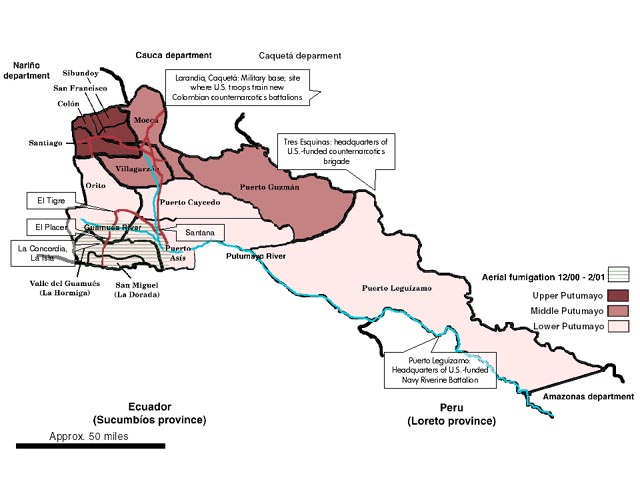  |
Despite
Putumayo’s population explosion, the Bogotá government did little
to make its presence felt. Police, judges, hospitals, schools, banks,
and decent roads are very rare. Where they exist, electricity and
running water are very recent arrivals. Government neglect not only
brought a lawless "wild west" atmosphere, it also made it
virtually impossible to make a living legally once the "bonanzas"
faded away. With no credit, no roads, and no integration into national
markets, agricultural products cost too much to produce, and none
yielded any profit. That is still the case today. "The corn we
grow on a hectare (2.5 acres) costs 300,000 pesos (about US$150) to
produce and get to market," a peasant leader told us. "We
can’t sell it for that much."
A new
"bonanza" began when enterprising narcotraffickers, taking
advantage of the late-1970s U.S. appetite for cocaine, encouraged
some local farmers to grow coca. The illegal crop caught on quickly.
It grows like a weed in the otherwise poor soils of lower Putumayo,
allowing farmers to harvest its leaves four or five times per year.
Through a process involving gasoline, cement, and a few other chemicals,
producers create a white "paste" from the leaves in their
"laboratories" – really just sheds with a concrete
floor and a few 55-gallon drums. Leaves harvested from a hectare of
coca plants yield roughly two kilograms (4.4 pounds) of paste. This
compact load is easy to transport in an area whose few roads are difficult
enough for four-wheel-drive vehicles, much less cargo trucks, to negotiate.
"For any peasant, a backpack full of coca paste is better than
a truckload of potatoes," a local leader explained. Plus, a market
for the coca paste is guaranteed. Comisionistas, or middlemen,
pay a decent price in cash – about 2 million pesos (US$1,000)
per kilogram – an amount that rises after government eradication
efforts temporarily reduce supply.
While
no business or crop approaches coca’s profitability in Putumayo,
the farmer who grows it is the poorest link in a very long chain.
The kilogram of coca paste that nets farmers $1,000 will eventually
be turned into cocaine sold for over $100,000 on the streets of the
United States or Europe. But the farmer’s $1,000 is not even
pure profit. From that must be taken the cost of seeds, fertilizers
and pesticides, processing, and "taxes" charged by the FARC
guerrillas or right-wing paramilitaries (who often buy the coca paste
directly at artificially low prices). What is left for a farmer with
one or two hectares of coca is little more than Colombia’s legal
minimum wage of 286,000 pesos (about US$140) per month.
This
fits the living conditions of the coca-growing peasants we visited
in Putumayo. Families with one or two hectares generally lived in
one-room tin-roof wooden sheds – they could hardly be called
houses – without plumbing, electricity or nearby transportation.
Those with four or five hectares (an amount that, local authorities
told us, very few exceeded) appeared to be approaching middle class.
They had small houses made of painted cinder blocks, with a motor
scooter (one sees few cars on Putumayo’s roads), perhaps a TV
and VCR, and a refrigerator.
|
Putumayo: the latest
stop for South America’s wandering coca trade
Though
Putumayo has known coca since 1979, it was not a significant coca-growing
location until very recently. In fact, until the mid-1990s Colombia
itself was a distant third, behind Peru and Bolivia, among the
world’s main coca producers.
Colombia’s
Medellín and Cali drug cartels did not encourage much coca growing
on Colombian soil. Their networks bought coca grown in Peru and
Bolivia, then processed the coca base in Colombia and smuggled
out the finished product. This system had broken down by the mid-nineties,
though. The cartels had been smashed, the United States and Peru
were disrupting the aerial routes between growing areas and Colombian
processing sites, and some alternative development programs were
successfully weaning Peruvian and Bolivian peasants off of illegal
crops.
Colombia’s
narcotraffickers, now split among a multitude of smaller micro-cartels,
did not give up. They started buying Colombian-grown coca, spurring
a rapid expansion in Colombian coca cultivation that began around
1994-1995. But Putumayo, while a significant source, did not become
Colombia’s cocaine capital until a few years after that.
Colombia’s
mid-1990s center of coca production was in the departments of
Guaviare and Caquetá to the north of Putumayo, several hundred
miles closer to Bogotá (see map on facing page). In 1996, these
two departments combined for 60,400 of Colombia’s 69,200
hectares of coca, with only 7,000 planted in Putumayo.
Since
late 1995 the U.S. government and the Colombian National Police
have run a fumigation program in Guaviare and Caquetá, with aircraft
on regular spray missions raining the chemical glyphosate (the
active ingredient in the herbicide "Round-up") on the
coca fields. These fumigations went on for years without any U.S.
assistance for the affected peasants, such as efforts to ease
a transition to legal crops. The logical and foreseeable result
was that coca growers simply relocated out of the spray planes’
range – and new coca fields sprung up all over Putumayo in
the late 1990s.
By
2000, Colombia’s government estimated, over 55,000 hectares
in Putumayo were planted with coca – an eightfold growth
in four years. (In January 2001 the U.S. embassy said that this
figure "could be as high as 90,000 hectares.")
|
|
|
The mayor
of Puerto Asís, Putumayo’s largest city, Manuel Alzate is an
able politician whose skill with sound bites would take him far in
Washington. Mayor Alzate heaped scorn on the myth that Putumayo’s
peasants are getting wealthy from the coca trade. "If that were
true you would have seen at least some improvement after twenty years
of growing coca here. But the peasants’ houses look as miserable
as they did twenty years ago – son igualitas." Indeed,
Colombia’s planning ministry has found that 77 percent of Putumayo’s
households cannot meet their basic needs.
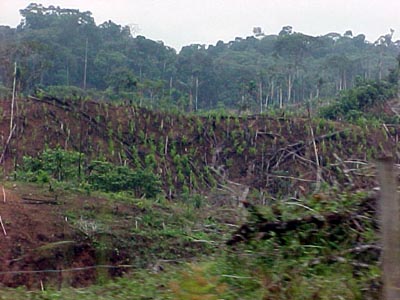 |
|
A
coca field in the Guamués valley. We took this photo
from the road.
|
Putumayo
is now overrun with coca, and nowhere more heavily than in the Guamués
River valley in the department’s southwest corner. On the road
from Puerto Asís to La Hormiga, the valley’s largest town, the
coca fields are hidden from view until southern Orito municipality
(county), when they become visible from the road. In what had been
dense jungle, neat rows of bright green bushes now grow amid the fallen
trunks of old-growth trees. Further south in the Guamués valley, the
coca bushes grow right up to the edge of the road.
About
90 percent of the farmers in this zone grow coca. Though the crop
is officially illegal, it is now part of the local culture. Coca has
given them, along with an army of young migrant leaf-pickers, or raspachines,
a guaranteed income in a country where official unemployment exceeds
20 percent. Middlemen and traffickers further up the production chain
have grown far wealthier. But many leaders complained to us that with
the easy money has come a "degenerate culture." Coca has
brought a weak work ethic, and none see education as necessary for
social mobility.
Violence
is at the core of this culture, and signs of it are everywhere in
Putumayo today. "Life in Putumayo is not worth 1,500 pesos (75
U.S. cents)," a peasant association leader told us. (Mayor Alzate
said the same thing, except 100 pesos.) In La Hormiga, we were told
that bodies by the roadside are a common early-morning sight. The
road into town is lined with bars where the region’s coca-pickers
come to drink, with curtains instead of doors and teenage prostitutes
called sardinitas loitering outside. Occasionally a patrol
from the nearby army battalion – three or four scared-looking
eighteen-year-olds carrying automatic weapons and rocket-propelled
grenades – walks down the main streets. A sign at the front desk
of our hotel read, "For your safety and ours, we pull down the
front gate at 11:00 PM. No exceptions." We spent a tense Saturday
night behind that gate, sleeping lightly amid the din of competing
vallenato tunes from La Hormiga’s many bars, the roar
of motorcycles, and occasional gunfire.
The
guerrillas
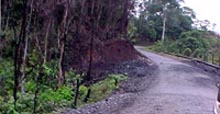 |
|
A
recently blown-up pipeline.
|
On the road
outside Villagarzón, we stopped at a roadblock that the local army battalion
had set up just outside its base (and only two or three miles beyond
the roadblock that the counternarcotics police had set up outside their
base). A friendly soldier looked through our bags, and asked where
we had come from. "La Hormiga," we told him; about a hundred
miles and five hours away. The soldier smiled and asked, "You didn’t
see any guerrillas, did you?"
We did
not see any of the FARC (Colombian Revolutionary Armed Forces) guerrillas
on our trip, but while on the road we saw ample evidence of their
presence, and of the freedom of operation they obviously enjoy in
rural Putumayo. Our truck fishtailed through crude oil from guerrilla
bombings of the roadside pipeline leading out of Ecuador. Remnants
of pipeline bombings are a frequent roadside sight in Putumayo; we
passed through dozens of circular spots, usually about fifty feet
in diameter, in which everything – the road, the ground, plants
and trees – had been coated with a uniform black by the spilled
oil and flames. Puddles of crude formed by the roadside, or fouled
nearby ponds and streams. We drove through one spot that had been
bombed so recently that some of the oil on the ground was still smoking.
We saw
the burned remains of cars and buses that tried to defy the FARC’s
restrictions on road travel. We passed cargo trucks bearing slogans
(including "Plan Colombia = plan for war") that the guerrillas
spray-paint at roadblocks, warning the truck drivers against removing
them. Passing through a forested area, a fellow passenger asked our
driver, "this is the zone where they’ve been holding people
up, isn’t it?" "Yes, just about every day," he
replied. Nobody travels on Putumayo’s roads between 6 PM and
6 AM.
The FARC
established a permanent presence in Putumayo during the early 1980s.
It was not the first guerrilla group to operate in the area; the leftist
M-19 and Maoist EPL had been active in Putumayo during the late 1970s
and the beginning of the 1980s, but both had vacated the zone by the
time the FARC’s 32nd Front arrived. Another front, the 48th,
was created in Putumayo in the early 1990s, and several fronts from
neighboring departments also pass through frequently.
Until
very recently, the FARC were the undisputed masters of Putumayo, and
though they have lost town centers to the paramilitaries, the guerrillas
clearly continue to dominate rural areas. FARC fronts forcibly recruit
new members, including teenagers, in Putumayo’s villages. The
guerrillas force still others to undergo military training, then threaten
harm to their families if they leave the area.
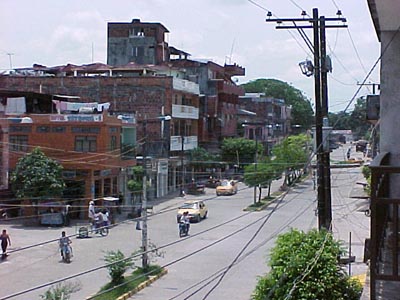 |
|
Puerto
Asís.
|
The FARC
also has a close relationship to Putumayo’s coca trade. They
charge "taxes" on coca production, as they do with all economic
activity in the areas that they control. Local producers told us that
they have also begun to go further than mere taxation, buying the
coca paste themselves at fixed prices.
In 1996,
after the U.S.-supported fumigation program began in Guaviare and
Caquetá to the north, the FARC organized massive peasant protests
throughout southern Colombia, including Putumayo. Weeks of marches,
with some violence, ended when the Bogotá government agreed to carry
out infrastructure projects, crop substitution programs, and development
assistance. The government never came close to following through on
its commitments, though, and the 1996 marches are generally regarded
as a failure. The local peasants, who lost income because the protests
took them away from their land, directed their anger and mistrust
not just at Bogotá, but also at the FARC.
The marches,
the forced recruitments, and the increasing levies on the coca trade
have deeply eroded the FARC’s base of support. Some whom we interviewed
spoke in almost nostalgic terms about the guerrilla leaders who had
run Putumayo during the 1980s and early 1990s, describing them as
fair and understanding of the local peasants. But "coca changed
the FARC," they said. As the FARC’s Southern Bloc became
wealthier and militarily successful, its leaders in Putumayo –
including Joaquín Gómez, now a member of the top leadership –
occupied themselves less with their support base and more with the
coca trade’s contributions to their war chest.
The
paramilitaries
In many
of Putumayo’s towns one sees the very open presence of another
illegal armed group, the United Self-Defense Forces of Colombia (AUC),
the country’s main right-wing paramilitary organization. In the
coca zones of lower Putumayo, entering a populated area – whether
a small city or a crossroads town – can feel almost like entering
another country. This is paramilitary territory, where dozens of the
men the locals call "power rangers" operate in plain sight,
usually dressed in civilian clothes.
La Dorada,
a town in the southern Guamués valley very close to the Ecuador border,
has a beautiful central park that the municipal government completed
in the middle of 2000, after much persuading of the FARC guerrillas
who then dominated the town. The park was almost completely empty
when we visited La Dorada – no children on the brightly painted
jungle gym, nobody walking on the manicured lawn, and nobody sitting
on the new benches. In fact, the whole town center was empty, except
for groups of young men, many of them obviously well armed.
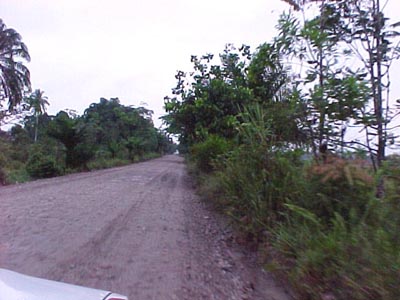 |
|
Driving
down Putumayo’s bumpy main road.
|
The paramilitaries
forced the FARC out of La Dorada with a massive incursion that started
on September 21, 2000. It did not take them long to install themselves
permanently. As elsewhere, they did it not by defeating the FARC militarily
– though firefights in the middle of town were a near-daily occurrence
for months – but by killing and displacing civilians they considered
to be guerrilla collaborators. Paramilitary fighters also carried
out what they call "cleansing" of suspect civilians in the
rural villages surrounding La Dorada. While the full extent of their
rampage is unknown, by early October more than 800 displaced people
from the surrounding countryside had arrived in La Dorada. Many more
went elsewhere, including Ecuador.
After
speaking with local officials, including the government human rights
ombudsman (who has been unable to leave this small town since last
August), we hurried out of La Dorada before the guerrilla restrictions
on road travel began. By the roadside at the entrance to the town
were two armed paramilitary guards in civilian clothes, one talking
into a field radio. About half a mile further, perhaps fifteen minutes
from the La Hormiga army base, we came upon a column of about ten
men in camouflage fatigues with "AUC" stenciled in white
letters on the back, carrying Galil rifles and walking down the middle
of the main road. We proceeded slowly and they let us pass, staring
at us. While we didn’t stare back, we couldn’t help noticing
that most of them appeared well over thirty years old, quite different
from the young conscripts the army sends on patrol or the child soldiers
the guerrillas recruit. Perhaps they had prior experience in other
military organizations.
While
La Dorada is one of the AUC’s latest conquests, the paramilitaries
themselves are recent arrivals in Putumayo. The group, founded in
northern Colombia and funded by landowners and narcotraffickers, was
unheard of in Putumayo until after the 1996 anti-fumigation protests,
when their leader, Carlos Castaño, announced the formation of a bloc
of "southern self-defense groups." They swept into the region
in late 1997 and early 1998 with a series of horrific massacres and
selective killings. Since then they have moved quickly. By 1999 paramilitaries
had gained control of Puerto Asís, and by early 2000 they controlled
La Hormiga, Orito, and the roadside village of El Placer, where they
maintain a base of operations. They took La Dorada in September 2000
and in December, in an operation that local leaders say has since
killed 120 people, they established themselves in Puerto Caicedo.
A few
towns in the southwestern Putumayo coca zone still remain under FARC
control. One is El Tigre, along the main road in Orito municipality.
While the AUC does not control El Tigre, its residents remember when
they first appeared on January 9, 1999, a few days after the government
began peace talks with the FARC. A column of 150 paramilitaries swept
through, killing twenty-six people in the main square and disappearing
fourteen more. Locals told us that after the massacre, the first vehicles
allowed to proceed into town had to swerve to avoid hitting dead bodies
in the road. Others told of people being hacked to death with machetes
and thrown into the nearby river. The paramilitaries may be back again
soon. Driving through the town, we saw a chilling message in fresh
graffiti painted on a house: "AUC – we’re here to stay.
El Tigre will be erased from the map."
While
they mainly dominate town centers, the paramilitaries are active in
rural areas around the towns they control, killing hundreds and displacing
thousands. They maintain roadblocks and tightly control access to
and from the towns. Indigenous leaders told us that it is unsafe for
them to travel alone on the rivers because the AUC stops them and
questions them about their business. The paramilitaries also "tax"
coca production, and many analysts speculate that their offensive
in Putumayo has more to do with increasing their coca income than
with carrying out an anti-guerrilla crusade.
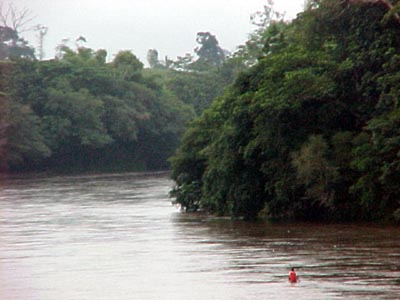 |
|
The
Putumayo River.
|
On condition
of anonymity, many whom we interviewed insisted that the paramilitaries’
success in Putumayo was made possible by the local military forces’
collaboration and toleration. Paramilitaries operate openly and unmolested
in Putumayo – as we saw for ourselves – and combat between
the Army and the AUC is exceedingly rare. Some sources told us of
joint actions, and of paramilitaries being present at military bases.
A reporter played us a tape of a recent interview with the head of
the 24th
Brigade (based in the capital, Mocoa) in which the colonel acknowledged
that the Brigade’s 59th
Battalion was replacing the 31st
Battalion at the La Hormiga base because the latter faced widespread
allegations of collaboration with the AUC.
In October
2000, a bold police officer denounced military-paramilitary cooperation
in Puerto Asís to local civilian authorities. According to the Bogotá
daily El Tiempo, the policeman reported that the paramilitaries
blatantly identify themselves with insignia and move easily in clearly
marked vehicles. The policeman said he did not understand "the
abilities and skills that they use to make a mockery of the Army’s
roadblocks, and to station themselves right in front of them."
He added that he had heard numerous charges that the local army command
meets regularly with paramilitary leaders at a well-known compound
called Villa Sandra. The site, in the town of Santana just north of
Puerto Asís, is only a few hundred yards from an Army base currently
occupied by a brand-new U.S.-funded counternarcotics battalion. (We
did not see any people on the grounds of Villa Sandra on the two occasions
that we passed the site.)
In its
mid-March 2001 report, the United Nations High Commissioner for Human
Rights cites a permanent paramilitary roadblock in El Placer, the
continued existence of the Villa Sandra paramilitary base, including
its use as a site for military-paramilitary meetings, and the prolonged
AUC takeover of La Dorada despite the proximity of an army base in
nearby La Hormiga.
|
Excerpt
from the UN High Commissioner for Human Rights’ 2000 report
(Published
February 8, 2001 and released in March 2001)
At
the entrance to the village of El Placer, a notorious paramilitary
roadblock exists just fifteen minutes from La Hormiga, where
an army battalion belonging to the 24th Brigade is based. Eight
months after the [High Commissioner’s] Office reported
observing this directly, the roadblock was still in operation.
The military authorities denied in writing that this paramilitary
position exists. The Office also observed that at the hacienda
"Villa Sandra," between Puerto Asís and Santana, the
paramilitaries are still operating only a few minutes from the
24th Brigade’s installations. Afterward we were informed
of two searches of the site carried out by the security forces,
which apparently found nothing. However, the existence and maintenance
of this paramilitary position is a matter of full public knowledge,
so much that it was visited several times by international journalists,
who published their interviews with the paramilitary commander
there. Testimonies received by the Office have even included
accounts of meetings between members of the security forces
and paramilitaries at "Villa Sandra." At the end of
July [2000], the Office alerted the authorities to an imminent
paramilitary incursion in the town center of La Dorada, in San
Miguel municipality [county], which indeed happened on September
21. The paramilitaries remain there, even though the town is
only a few minutes from the army base at La Hormiga.
|
Another
factor in the paramilitaries’ takeover was the local population’s
growing disenchantment with the guerrillas. While this goes back to
the failed 1996 peasant marches, the FARC has made things worse for
itself with its heavy-handed response to the paramilitary offensive.
The guerrillas have consistently chosen to retaliate in ways that
inflict more harm on the civilian population than on the paramilitaries,
such as killing unfamiliar people and setting off car bombs in town
centers.
After
the paramilitary takeover of La Dorada, the FARC shed even more goodwill
by mounting an "armed stoppage" aimed at isolating the paramilitaries
in the towns. For over eighty days starting in late September 2000,
the guerrillas banned all travel on Putumayo’s roads, setting
fire to any vehicles they found. (The roadsides remain littered with
oxidized heaps of twisted metal that vaguely resemble car and bus
chassis.) Townspeople were prisoners in their towns, while much of
the countryside was brought to the brink of famine.
Residents
of La Dorada told us of the trauma of living through the bloody paramilitary
takeover followed by the armed stoppage. After the FARC lifted the
vehicle ban in mid-December there was about a seven-day pause when
"people even felt safe to use the park." Then, on December
19, the fumigations began.
Fumigation
and the U.S. aid package
Between
December 19 and early February, a U.S.-funded Colombian military and
police operation sprayed glyphosate on 25,000 to 29,000 hectares (62,500
to 72,500 acres), nearly all of it in the Guamués River valley. It
was the first U.S.-supported spray operation ever in Putumayo, and
the first visible result of a two-year, $1.3 billion aid package for
Colombia and its neighbors that President Clinton signed into law
in July 2000.

The aid
package was billed as a contribution to "Plan Colombia,"
a $7.5 billion Colombian government program aimed at fighting drugs
and strengthening Bogotá’s ability to govern. Colombian government
officials insist that their program is only 25 percent military and
police aid, with the other 75 percent going to social and economic
programs. With $860 million coming from last July’s aid package,
the United States is providing Colombia $1.165 billion during 2000
and 2001. Of this amount, $929 million – 80 percent – is
aid for Colombia’s military, police, and fumigation program,
most of it focused on Putumayo.
The centerpiece
of this program is "the push into southern Colombia" –
a military offensive designed to make fumigation possible in Putumayo.
U.S. policymakers decided against duplicating the fumigation model
used for years in Guaviare and Caquetá departments to the north, where
U.S. contractor pilots fly spray missions accompanied by police escort
helicopters. Because of the heavy presence of armed groups who shoot
back at the spray planes, fumigating Putumayo was considered too dangerous
without a large military effort. As a result, last year’s aid
package included funds to create three new battalions in the Colombian
Army, which are to receive dozens of Blackhawk and upgraded Huey helicopters.
The battalions’
mission is to make Putumayo safe for fumigation by fighting off any
armed groups in the zones to be sprayed. As former U.S. Southern Command
chief Gen. Charles Wilhelm told a Senate committee, with the 2,300
men in the three battalions "Colombia can achieve a ‘one-two
punch’ with the armed forces preceding the police into narcotics
cultivation and production areas and setting the security conditions
that are mandatory for safe and productive execution of eradication
and other counterdrug operations by the CNP [Colombian National Police]."
Critics worry that "setting the security conditions" may
require U.S.-aided units to engage in regular combat with insurgent
and paramilitary groups, bringing Washington closer than ever before
to Colombia’s civil war.
The military
money is being spent in a hurry. Two of the three battalions are ready
for action, and the third will complete training in May 2001. Though
the State Department originally scheduled to deliver the first helicopters
in October 2002, congressional hard-liners’ bitter complaints
moved the delivery date up to July 2001. In December 2000, with two
battalions ready and thirty "temporary" 1970s-vintage helicopters
delivered, the United States gave the green light to fumigation in
Putumayo.
With
the battalions and the police operating on the ground, a fleet of
Turbo Thrush spray aircraft accompanied by Colombian Police and Army
helicopters flew daily missions over the Guamués valley. They sprayed
"Round-Up Ultra," a combination of glyphosate and two additives
(known as Cosmo Flux-411f and Cosmo-iN-D) that help the poison stick
to the coca leaves and keep the spray nozzles from getting clogged.
U.S.
government officials are telling Congress and the media that this
first phase of spraying was a huge success. "Overall, operations
in southern Colombia have gone much better than expected with only
minimal local opposition, few logistical problems, and no major increase
in displaced persons," Assistant Secretary of State for International
Narcotics Affairs Rand Beers told a congressional subcommittee in
late February.
 |
|
Fumigated
coca bushes outside La Hormiga.
|
The spray
planes and battalions encountered surprisingly little resistance.
In the first seven weeks of the eight-week effort, eight spray planes
and escort helicopters were hit by ground fire, with no injuries or
serious damage. This is far safer than Guaviare and Caquetá, where
in 2000 the planes were hit fifty-six times while spraying 47,000
hectares – four times as often per hectare sprayed. Colombian
forces "setting the security conditions" were involved in
only five minor combat incidents, three with the FARC, one with the
paramilitaries, and one with an unknown assailant who fired a rocket-propelled
grenade at a fuel plane (some speculated that it was a firework).
The spray operation took place in conditions so safe that eradication
could almost have been performed manually.
We asked
a wide range of people why the fumigation met so little resistance.
Some argued that the Colombian Army, including the new battalions,
did indeed manage to create the necessary security conditions. Gonzalo
de Francisco, the Colombian government official in charge of anti-drug
activities in Putumayo, said that the lack of resistance owed to good
coordination between the army and the police and the local population’s
confidence in upcoming crop-substitution programs.
This
rationale does not explain, however, how the fumigations proceeded
in a FARC stronghold with so few combat incidents. The answer to that
lies in the State Department’s explanation that "the original
spray area was an area dominated, for the most part, by the AUC paramilitary
institution."
This
is true, though the fumigation zones became "paramilitary dominated"
only very shortly before the spray planes arrived. Much of the area
where fumigation occurred between December 2000 and February 2001
– La Dorada, La Hormiga and surrounding San Miguel and Valle
del Guamués municipalities – was subject to a paramilitary campaign
of murders and forced displacement that greatly reduced the presence
of guerrillas in the months leading up to the spraying. With the FARC
cleared out, the paramilitaries who took over allowed the fumigation
program to operate unhindered. A paramilitary leader in Putumayo named
"Enrique" told the Miami Herald’s Juan Tamayo in January
that "his men are under orders not to shoot at the planes, saying
in an interview that while he ‘taxes’ area coca dealers
to finance AUC operations, ‘we are 100 percent in favor of eradication.’"
Some
people we spoke with in Putumayo wondered whether any connection exists
between the late 2000 paramilitary offensive and the December 2000
onset of fumigation. Though we found overwhelming evidence of military-paramilitary
collaboration in the area, we found no evidence of a conscious strategy
to employ paramilitaries specifically to ease the first phase of fumigations.
We are
nonetheless convinced that U.S.-aided Colombian units do not get all
the credit for the lack of resistance to the spray aircraft. The fumigations
between December 2000 and February 2001 were eased – security
conditions were established – by the paramilitaries’ often
brutal activities in the fumigation zone in the months preceding the
spraying.
The
"industrial" coca-growing zone
As we
drove into the Guamués valley, the lush green of Putumayo rather suddenly
gave way to yellow and brown. We had entered the zone the spray planes
had flown over several weeks earlier. The herbicides clearly did their
job; walking through the coca fields, it was even possible to tell
which way the wind was blowing when the planes came. But they killed
everything else, too. The barren landscape was punctuated with dead
underbrush and severely damaged old-growth trees. In a field of plantains
rotting on dried-out trees, we watched a troop of monkeys foraging
for food.
U.S.
officials had told Congress and the public since mid-2000 that the
Guamués valley would be the target area for the first fumigations.
They characterized the area as a zone of "industrial" coca-growing,
with large plantations run by distant drug lords. The vast majority
of the population, they said, was a "floating population"
of young male migrant workers and raspachines.
On March
12, 2001, while we were still in Putumayo, Deputy Assistant Secretary
of State for Western Hemisphere Affairs Bill Brownfield explained
this position to reporters at a briefing in Washington. "For
the most part, most of those who were sprayed, most of the land that
was sprayed in the December/January/February time-frame in Putumayo
… were, by our estimation, what we call industrial-sized coca
plantations or coca-cultivated areas. Industrial size, meaning too
large to be managed by a single campesino [peasant] or campesino
family as part of a long-term, multi-generational presence on
a specific piece of land. These were fairly large in size."
Though
it is still bustling, locals told us that La Hormiga is a ghost town
compared to a few months ago, before the spraying started. It is certain
that, as the U.S. aid program foresaw, much of the zone’s "floating
population" did indeed float away. But they left behind thousands
of peasant families, small landholders whom the fumigations have left
with no way to support themselves.
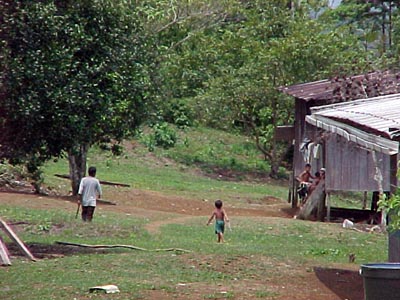 |
|
Children
in the town of La Isla in the “industrial” coca-growing
zone.
|
In aerial
surveillance and satellite photos, many of the Guamués valley’s
coca fields may resemble "industrial" plantations. The reality
on the ground is quite different. We walked through coca fields that
seemed to stretch as far as the eye could see, but from the ground
it was obvious that these were small parcels of individually owned
land adjoining each other. Several people told us that individual
plots rarely exceed four hectares, with the largest few reaching seven
or eight. San Miguel municipality, in the heart of the zone, has 18,000
hectares of coca divided among a rural population of 20,000.
Because
of the belief that this is an "industrial" zone, the U.S.
government has allocated nothing for humanitarian aid or alternative
development assistance in the area sprayed in December, January and
February. The many families in the zone, who have lost both their
coca and their food crops, fall outside the focus of the meager economic
component of the U.S.-funded program in Putumayo. Though officials
in Bogotá say that some aid has been delivered with Colombian government
funds, we spoke with nobody who had received any.
We stopped
in the roadside town of La Concordia, north of La Hormiga, where the
planes sprayed everything – food crops, people’s houses,
the school, the soccer field, the road itself. A farmer named Rigoberto
showed us his destroyed fields. There was no doubt that he had planted
his food crops alongside his coca. The fumigation planes did not violate
procedure when they destroyed all of his crops, legal and illegal.
The result, however, is that he and his family are left with nothing
to eat.
 |
|
Destroyed
alternative development projects in La Isla: a chicken coop
(above) and a fish pond (below).
|
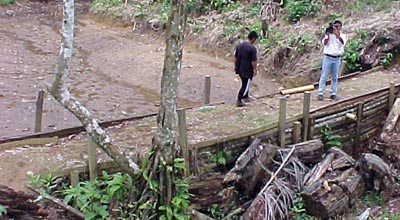 |
We asked
Rigoberto what he and his neighbors are doing – were they planting
food, how were they feeding themselves. He said that many in La Concordia
were now "aguantando hambre" – suffering from
hunger. Since everybody expected the fumigation planes to come back
soon, they were not planting anything, legal or illegal. "We
spend the day here with our arms crossed, wondering what to do."
Even though La Concordia is on the main road – no need to hike
into the backcountry – no humanitarian aid had reached its residents.
The State
Department’s Brownfield explained that no aid will be forthcoming
for families like Rigoberto’s who planted both coca and food
crops on the same plot of land in the "industrial" zone.
"The campesino who is intentionally hiding, concealing
or trying to protect illicit cultivation of coca or opium poppy isn’t
going to get a tremendous amount of support or concern or commiseration
if he is sprayed," he told the March 12 briefing.
La Isla,
a village not far from La Concordia, was one of the first towns to
be fumigated. The locals said the planes came on December 22. The
planes passed over the town itself, misting Round-up Ultra through
their shacks’ glassless windows. The herbicides killed all of
the residents’ food crops, and destroyed two nearby development
projects designed to create legal economic alternatives. One was a
former coca-paste lab that had been turned into a chicken coop with
funding from PLANTE, the Colombian government alternative development
agency. The other was an aquaculture project. Both the chicken coop
and the man-made pond were empty; La Isla residents told us that the
chickens and the fish were dead within a few days of the spraying.
 |
|
These
coca plants, cut back just after fumigation, are quickly growing
back.
|
Though
glyphosate is a water-soluble herbicide that is supposed to break
down within a few days, farmers in La Isla told us that they still
cannot get anything to grow. "The seeds germinate, grow for a
few days, then die," one resident said. In fact, the only crop
that seems to be doing well is the coca itself. Local growers have
found that when they cut the coca bush back to its main stem before
or shortly after the spraying, it grows back rapidly and yields more
leaves than before. We walked through several fields where bright-green
knee-high coca plants grew among dead banana trees and brown underbrush.
U.S.
officials have categorically denied that the fumigations could be
the cause of any health problems among the affected population. In
a meeting with the head of the U.S. embassy’s narcotics section,
Mayor Alzate was told that glyphosate is so safe that one could drink
a water glass full of it. (The official declined Alzate’s request
that he do so.)
 |
|
This
baby’s mother said her skin condition appeared just after
the spray planes hit La Isla in December.
|
Yet we
both saw and heard evidence that the spraying had sharply increased
cases of skin outbreaks, gastrointestinal disorders like vomiting
and diarrhea, and respiratory ailments. A physician in La Hormiga
told us that young children were the most heavily affected, and that
the effects appeared to be stronger at the outset of the fumigations
in late December. He speculated that perhaps the additives in the
spray mix were to blame. Most people no longer showed symptoms when
we arrived many weeks later; most remaining skin disorders had faded
to a few patches. In La Isla, however, we saw a five-month-old baby
whose skin was covered with bumps, scabs and rashes. Her mother said
that the condition appeared immediately after the spray planes flew
over the town in late December, and that because she scratches herself,
the inflammation has only grown worse.
Putumayo’s
indigenous communities, especially the Cofán people of the Guamués
valley, have also been hit hard by the fumigations. Indigenous leaders
told us that while they plant little coca themselves, their reservations
have been invaded by illegal squatters (colonos) who grow significant
amounts, attracting the fumigation planes. The spraying destroyed
both indigenous communities’ food crops and their sacred ceremonial
crops, such as yagé.
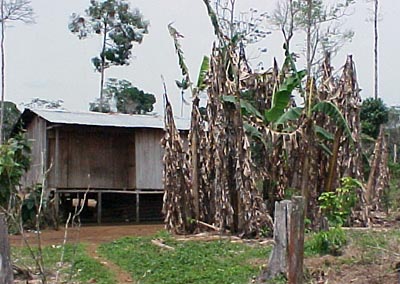 |
|
Dead
banana trees indicate that the spray planes passed directly
over this shack.
|
Without
humanitarian and alternative development assistance, the families
we did not expect to find in the "industrial zone" may soon
be facing famine. Or they may choose to relocate elsewhere into Colombia’s
California-sized jungles, knock down a few more hectares of trees,
and plant more coca.
A January
28 U.S. Embassy document claims that "there has been minimal
displacement, with some 20-30 people displaced since spray operations
began in mid-December." Everyone in Putumayo to whom we read
this statistic reacted with disbelief. Since the fumigations began,
leaders in La Dorada told us, peasants have been leaving the area
by the truckload – about four or five loads per day.
Many
of those displaced are planting new coca elsewhere in Colombia. A
common destination is Nariño department to the west, where coca cultivation
is now increasing rapidly. Others are moving to Puerto Leguízamo municipality
in southeastern Putumayo, to Colombia’s large, empty department
of Amazonas, and across the border into Ecuador. By many accounts,
the fumigations of December through February brought a 25 percent
increase in the price of coca paste, making coca-growing that much
more attractive. "When they fumigate forty hectares, eighty more
appear," Puerto Asís Mayor Alzate told us.
The
social pacts
U.S.
and Colombian officials are quick to emphasize that their plans in
Putumayo go beyond military offensives and aerial fumigation. They
point out that they have made funding available for a series of "social
pacts" with local producers who are willing to give up coca voluntarily.
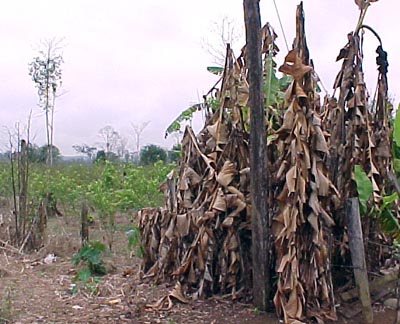 Peasants
who sign the pacts agree to eradicate their coca manually within twelve
months in exchange for funding, credit, and technical assistance for
the cultivation of legal crops. The agreements, signed with hundreds
of farmers in a single community, are managed by the Colombian government
alternative development agency (PLANTE) and carried out by a non-governmental
organization (NGO) working on a contract basis. Each contracted NGO
will manage five pacts. The farmers who sign the pacts will receive
in-kind assistance valued at 2 million pesos (about US$1,000), and
will have access to credit and technical assistance (one technician
will be assigned to each 100 farmers). Infrastructure projects, such
as road building, are also foreseen. Farmers who do not eradicate
their crops within twelve months of receiving funds will face fumigation. Peasants
who sign the pacts agree to eradicate their coca manually within twelve
months in exchange for funding, credit, and technical assistance for
the cultivation of legal crops. The agreements, signed with hundreds
of farmers in a single community, are managed by the Colombian government
alternative development agency (PLANTE) and carried out by a non-governmental
organization (NGO) working on a contract basis. Each contracted NGO
will manage five pacts. The farmers who sign the pacts will receive
in-kind assistance valued at 2 million pesos (about US$1,000), and
will have access to credit and technical assistance (one technician
will be assigned to each 100 farmers). Infrastructure projects, such
as road building, are also foreseen. Farmers who do not eradicate
their crops within twelve months of receiving funds will face fumigation.
So far,
the Colombian government has signed four pacts. The U.S. government’s
aid package has sponsored two of these: a December 2, 2000 pact in
Puerto Asís and a January 15 pact in Santana, a town in Puerto Asís
municipality. These two agreements incorporate 1,453 families. Two
others have been signed with Colombian funds: a February accord with
an indigenous community in San Miguel municipality, and a March 15
pact in Orito. The U.S.-supported pacts are outside the so-called
"industrial zone," which will get no U.S. economic aid at
all.
The region’s
coca-growing peasants, most of whom would welcome an opportunity to
abandon coca, are watching the pacts very closely. Their mistrust
of government alternative development programs dates back at least
to Bogotá’s noncompliance with the agreements that ended the
1996 anti-fumigation protests. It has been compounded by other colossal
failures, like a half-built wreck of a hearts-of-palm processing plant
that sits outside Puerto Asís, a monument to a PLANTE project that
never got off the ground.
The U.S.
embassy reported in late January, "The signing of even two elimination
agreements has had a positive effect, in that many more families are
interested in signing them now that they are perceived as a reality.
The signings appear to have lessened some local officials’ opposition
to aerial eradication as well."
 When
we came to Putumayo in mid-March, we found that not a cent had arrived
for those who had signed the pacts months earlier. Instead of an active
alternative development project, all we found were angry and discouraged
peasants. Because of a lengthy negotiation process with Fundaempresa,
the Cali-based NGO chosen to administer the first pacts, no aid had
been disbursed and nobody had contacted the signatories in Puerto
Asís and Santana to let them know what was happening. When
we came to Putumayo in mid-March, we found that not a cent had arrived
for those who had signed the pacts months earlier. Instead of an active
alternative development project, all we found were angry and discouraged
peasants. Because of a lengthy negotiation process with Fundaempresa,
the Cali-based NGO chosen to administer the first pacts, no aid had
been disbursed and nobody had contacted the signatories in Puerto
Asís and Santana to let them know what was happening.
Doubts
and uncertainty grew after an incident that was brought to our attention
several times during our trip. According to local leaders and the
affected farmers, in early February a contingent of troops from the
new U.S.-created counternarcotics battalions paid visits to thirteen
families in the villages of La Esperanza, La Planada, Bretania, Yarinal
and Santa Elena, in the municipality of Puerto Asís. The thirteen
families had signed the first social pact in December, and were awaiting
funds.
Gustavo
(name changed for security reasons), one of the farmers whom the battalion
visited, is one of the better-off coca-growers we met. He welcomed
us into his three-room house, with glass windows, a fan, a television,
stereo, and a shelf full of books. He told us that the soldiers from
the battalion came one morning, chatted with him and his wife, then
asked him to sign a paper certifying that he had been treated well.
Once he signed, the troops marched into his coca fields, pulled up
plants and burned his coca-paste laboratory.
Gustavo
protested that, as a signer of a social pact, he had twelve months
to eradicate his coca. He told us that the soldiers replied, "How
stupid and foolish you peasants are. You believe the politicians who
say they are going to help you. We don’t know of any Señor de
Francisco [Gonzalo de Francisco is the Colombian government official
in charge of anti-drug efforts in Putumayo]. The United States pays
us directly."
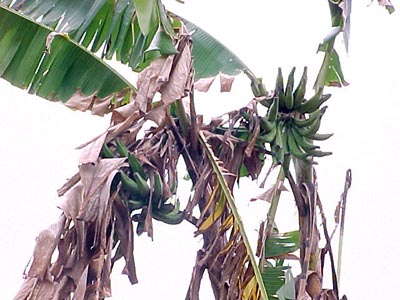 Whether
true or not, news of this incident has spread throughout Putumayo,
weakening peasants’ will to enter into future pacts. (Gonzalo
de Francisco told us that if the incident did occur, which he doubted,
it was an error.) While de Francisco told us on March 13 that disbursements
of funds for the first pacts should begin in four weeks, in Putumayo
there is a growing sense that the peasants are being fooled yet again.
"It’s all pure bureaucracy, they’re going to waste
it all on per diems," a peasant leader told us. "It will
be like the hearts-of-palm plant all over again." On a few occasions,
we found ourselves in the odd position of defending the U.S. government
before angry farmers, assuring them that this time the aid had to
arrive because it was included in U.S. law. Whether
true or not, news of this incident has spread throughout Putumayo,
weakening peasants’ will to enter into future pacts. (Gonzalo
de Francisco told us that if the incident did occur, which he doubted,
it was an error.) While de Francisco told us on March 13 that disbursements
of funds for the first pacts should begin in four weeks, in Putumayo
there is a growing sense that the peasants are being fooled yet again.
"It’s all pure bureaucracy, they’re going to waste
it all on per diems," a peasant leader told us. "It will
be like the hearts-of-palm plant all over again." On a few occasions,
we found ourselves in the odd position of defending the U.S. government
before angry farmers, assuring them that this time the aid had to
arrive because it was included in U.S. law.
It is
crucial that the funds for the pacts reach their destination with
no further delay. All eyes in Putumayo are on these initial projects,
and if they prove to be successful they could have an enormous demonstration
effect. Trust in the Colombian government could be established for
the first time, laying the groundwork for future coca-eradication
projects that do not depend on fumigation.
So far,
however, the residents of Putumayo have seen a rush to deliver helicopters,
train battalions and spray farmers, and a halfhearted attempt to carry
out economic alternatives. As of this writing, the U.S. approach to
Putumayo – whose supporters sell it as a "balanced approach"
– has been 100 percent military.
A better
approach
Everyone
we talked to in Putumayo – from mayors and council members to
farmers by the roadside – was adamantly opposed to fumigation.
While we were in Putumayo, the department’s governor was in Washington
spreading the same message. "Fumigation is not the solution,"
Iván Gerardo Guerrero told a press conference on March 12. "It
has a great defect. It doesn’t really take into account the human
being. All it cares about are satellite pictures."
We heard
uniform opposition to increased military aid as well. Those who live
in Putumayo’s day-to-day reality see the region’s problem
as social, and view a military response as absurd. "Instead of
sixty helicopters, the United States should be sending us sixty road-graders
or tractors," Mayor Alzate told us. The mayor scoffed at the
notion, heard often in Washington, that drug eradication in Putumayo
could weaken the FARC guerrillas by taking away their income. "The
guerrillas will be just as strong without coca. They can increase
kidnapping and extortion to support themselves. They’re powerful
in many parts of the country that don’t have any coca."
Putumayo
residents generally agreed that an effective coca-eradication strategy
must be manual, gradual, and mutually agreed with the affected communities.
The social pact structure includes these elements to some extent,
but ultimately fails on all three.
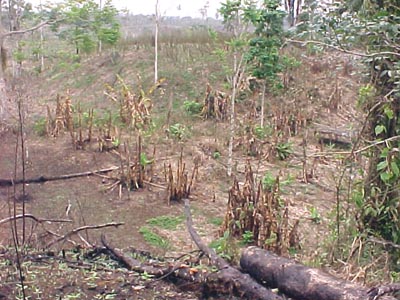 While
the pacts include manual eradication, they carry the threat of aerial
fumigation if coca plants are not pulled out in the agreed period.
The pacts allow producers to taper off coca-growing gradually over
twelve months, but most insist that the transition should be longer.
While coca can yield a first harvest within a few months, most other
crops will take longer, often well over a year, to bring in any income.
Most crops that thrive in the generally poor soils of lower Putumayo,
such as rubber, bananas, or hearts-of-palm, grow on trees that will
still be saplings after a year. Since 1999 the Municipal Rural Development
Commission of Puerto Asís, a prominent peasant group, has been promoting
a crop-substitution plan with a three-year tapering-off period. The
social pacts may risk failure unless the government either allows
signers to taper off coca-growing more gradually, or pays them a basic
wage while they await their first legal harvests. While
the pacts include manual eradication, they carry the threat of aerial
fumigation if coca plants are not pulled out in the agreed period.
The pacts allow producers to taper off coca-growing gradually over
twelve months, but most insist that the transition should be longer.
While coca can yield a first harvest within a few months, most other
crops will take longer, often well over a year, to bring in any income.
Most crops that thrive in the generally poor soils of lower Putumayo,
such as rubber, bananas, or hearts-of-palm, grow on trees that will
still be saplings after a year. Since 1999 the Municipal Rural Development
Commission of Puerto Asís, a prominent peasant group, has been promoting
a crop-substitution plan with a three-year tapering-off period. The
social pacts may risk failure unless the government either allows
signers to taper off coca-growing more gradually, or pays them a basic
wage while they await their first legal harvests.
Though
they take the form of a mutual agreement, the terms of the pacts are
handed down by the government in a "take it or leave it"
fashion. Local producers complain that Bogotá government officials
are imposing the pacts without ever consulting with the affected communities.
An indigenous leader suggested that Gonzalo de Francisco "come
to Putumayo more often and hold public discussions and forums with
the affected population, instead of just meeting with the mayors and
town council members." Leaders of agricultural and indigenous
organizations wondered why the government felt it necessary to contract
with organizations from outside the region, such as Fundaempresa,
to administer the aid and to design alternative development projects.
Some expressed alarm that many of the pacts may encourage farmers
to cultivate African palm (a source of palm oil), a non-native plant
that produces little employment per hectare.
Alternative
development, many pointed out, is more than just crop substitution.
The department is in desperate need of basic infrastructure, from
potable water to farm-to-market roads. Agricultural producers demand
assistance with marketing their produce, access to credit, and –
at least in the short term – a guaranteed price for their legal
crops. Education is another deeply unmet need; as much as 85 percent
of Putumayo’s population has never been in school beyond the
fourth grade.
These
initiatives would have a greater chance of success if the United States
would do more to reduce demand for drugs at home, especially by expanding
treatment programs for the hard-core addicts who account for most
domestic drug use. (While treatment funding did rise 41 percent since
1994, the White House Office of National Drug Control Policy notes,
funding for foreign anti-drug aid, most of it military, increased
by 175 percent.) Peasants in Colombia do not deserve a military approach.
Military and police efforts should be aimed higher up the drug-production
chain, against the drug kingpins, the importers of precursor chemicals,
and the financial entities that help the narcotraffickers launder
their money.
Washington
and Bogotá are likely to ignore the local population’s proposals
for a manual, gradual, and mutually agreed program and go ahead with
the spraying and battalions. This may indeed bring a sharp reduction
in the amount of coca grown in Putumayo. But the coca trade will continue
to flourish, powered by an endless army of unemployed and uneducated
migrants who will find a way to feed themselves elsewhere.
The U.S.
anti-drug strategy now underway in Putumayo – rapidly expanding
fumigation and seriously lagging development assistance – has
already been tried elsewhere in Colombia. So far, it has done little
more than inconvenience the coca trade, forcing it to relocate somewhere
else every few years while total acreage continues to increase. It
is this approach that caused Putumayo to be overrun with coca in the
late 1990s. The same response in Putumayo will succeed only in moving
coca growing to another patch of untouched jungle, either in Colombia
or across the border in Ecuador, Peru or Brazil.
The relocated
coca will bring environmental destruction, armed groups, random violence,
and further fumigation plans to places that still look the way Putumayo
did twenty years ago. "Look how we’ve destroyed our own
house," one longtime Putumayo resident said to us, lamenting
his region’s lost forests, beauty, and tranquility. If the United
States and Colombian governments change course in time, perhaps others’
houses can yet remain unspoiled.
The Center
for International Policy wishes to thank the CarEth Foundation, the
Compton Foundation, the General Service Foundation, the Stuart Mott
Charitable Trust, and the Academy for Educational Development for the
financial support that made our visit possible. We also send our deepest
expressions of gratitude to those who served as our guides and advisors
during our stay in Putumayo.
 |
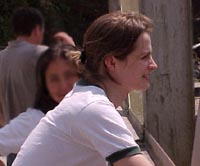 |
|
CIP
Senior Associate Adam Isacson (left) and Associate Ingrid Vaicius
(right) in Putumayo.
|
Center
for International Policy
1755 Massachusetts Ave., NW, Suite 312
Washington, DC 20036
(202) 232-3317
Fax: (202) 232-3440
cip@ciponline.org
www.ciponline.org
A Publication of the Center for International Policy
©
Copyright 2001 by the Center for International Policy. All rights reserved.
Any material herein may be quoted without permission, with credit to
the Center for International Policy. The Center is a nonprofit educational
and research organization promoting a U.S. foreign policy based on international
cooperation, demilitarization and respect for basic human rights.
ISSN 0738-6508
|



















 Peasants
who sign the pacts agree to eradicate their coca manually within twelve
months in exchange for funding, credit, and technical assistance for
the cultivation of legal crops. The agreements, signed with hundreds
of farmers in a single community, are managed by the Colombian government
alternative development agency (PLANTE) and carried out by a non-governmental
organization (NGO) working on a contract basis. Each contracted NGO
will manage five pacts. The farmers who sign the pacts will receive
in-kind assistance valued at 2 million pesos (about US$1,000), and
will have access to credit and technical assistance (one technician
will be assigned to each 100 farmers). Infrastructure projects, such
as road building, are also foreseen. Farmers who do not eradicate
their crops within twelve months of receiving funds will face fumigation.
Peasants
who sign the pacts agree to eradicate their coca manually within twelve
months in exchange for funding, credit, and technical assistance for
the cultivation of legal crops. The agreements, signed with hundreds
of farmers in a single community, are managed by the Colombian government
alternative development agency (PLANTE) and carried out by a non-governmental
organization (NGO) working on a contract basis. Each contracted NGO
will manage five pacts. The farmers who sign the pacts will receive
in-kind assistance valued at 2 million pesos (about US$1,000), and
will have access to credit and technical assistance (one technician
will be assigned to each 100 farmers). Infrastructure projects, such
as road building, are also foreseen. Farmers who do not eradicate
their crops within twelve months of receiving funds will face fumigation. When
we came to Putumayo in mid-March, we found that not a cent had arrived
for those who had signed the pacts months earlier. Instead of an active
alternative development project, all we found were angry and discouraged
peasants. Because of a lengthy negotiation process with Fundaempresa,
the Cali-based NGO chosen to administer the first pacts, no aid had
been disbursed and nobody had contacted the signatories in Puerto
Asís and Santana to let them know what was happening.
When
we came to Putumayo in mid-March, we found that not a cent had arrived
for those who had signed the pacts months earlier. Instead of an active
alternative development project, all we found were angry and discouraged
peasants. Because of a lengthy negotiation process with Fundaempresa,
the Cali-based NGO chosen to administer the first pacts, no aid had
been disbursed and nobody had contacted the signatories in Puerto
Asís and Santana to let them know what was happening. Whether
true or not, news of this incident has spread throughout Putumayo,
weakening peasants’ will to enter into future pacts. (Gonzalo
de Francisco told us that if the incident did occur, which he doubted,
it was an error.) While de Francisco told us on March 13 that disbursements
of funds for the first pacts should begin in four weeks, in Putumayo
there is a growing sense that the peasants are being fooled yet again.
"It’s all pure bureaucracy, they’re going to waste
it all on per diems," a peasant leader told us. "It will
be like the hearts-of-palm plant all over again." On a few occasions,
we found ourselves in the odd position of defending the U.S. government
before angry farmers, assuring them that this time the aid had to
arrive because it was included in U.S. law.
Whether
true or not, news of this incident has spread throughout Putumayo,
weakening peasants’ will to enter into future pacts. (Gonzalo
de Francisco told us that if the incident did occur, which he doubted,
it was an error.) While de Francisco told us on March 13 that disbursements
of funds for the first pacts should begin in four weeks, in Putumayo
there is a growing sense that the peasants are being fooled yet again.
"It’s all pure bureaucracy, they’re going to waste
it all on per diems," a peasant leader told us. "It will
be like the hearts-of-palm plant all over again." On a few occasions,
we found ourselves in the odd position of defending the U.S. government
before angry farmers, assuring them that this time the aid had to
arrive because it was included in U.S. law. While
the pacts include manual eradication, they carry the threat of aerial
fumigation if coca plants are not pulled out in the agreed period.
The pacts allow producers to taper off coca-growing gradually over
twelve months, but most insist that the transition should be longer.
While coca can yield a first harvest within a few months, most other
crops will take longer, often well over a year, to bring in any income.
Most crops that thrive in the generally poor soils of lower Putumayo,
such as rubber, bananas, or hearts-of-palm, grow on trees that will
still be saplings after a year. Since 1999 the Municipal Rural Development
Commission of Puerto Asís, a prominent peasant group, has been promoting
a crop-substitution plan with a three-year tapering-off period. The
social pacts may risk failure unless the government either allows
signers to taper off coca-growing more gradually, or pays them a basic
wage while they await their first legal harvests.
While
the pacts include manual eradication, they carry the threat of aerial
fumigation if coca plants are not pulled out in the agreed period.
The pacts allow producers to taper off coca-growing gradually over
twelve months, but most insist that the transition should be longer.
While coca can yield a first harvest within a few months, most other
crops will take longer, often well over a year, to bring in any income.
Most crops that thrive in the generally poor soils of lower Putumayo,
such as rubber, bananas, or hearts-of-palm, grow on trees that will
still be saplings after a year. Since 1999 the Municipal Rural Development
Commission of Puerto Asís, a prominent peasant group, has been promoting
a crop-substitution plan with a three-year tapering-off period. The
social pacts may risk failure unless the government either allows
signers to taper off coca-growing more gradually, or pays them a basic
wage while they await their first legal harvests.
